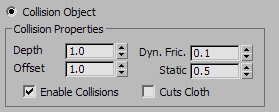Collision Properties control how a collision object behaves in a Cloth simulation. Cloth objects bounce off, wrap around, or are torn by collision objects.
Interface

- Depth
-
Collision depth for the collision object. If a portion of cloth reaches this depth inside a collision object, then the simulation will no longer try to push the cloth out of the mesh. This value is measured in 3ds Max units.
- Offset
-
The distance maintained between the cloth object and the collision object. A very low value can cause the collision mesh to protrude out from under the cloth. A very high value will look like the fabric is floating on top of the collision object. This value is measured in 3ds Max units.
- Dyn. Fric.
-
Dynamic friction between the cloth and this particular solid object. A larger value will add more friction and cause the fabric to slide across an object less. A lower value will allow the fabric to slip of an object very easily, similarly to how silk would react. This value is only used for interaction with cloth objects that have Use Solid Friction enabled, otherwise the friction value is taken from the cloth's own properties.
- Static [Friction]
-
Static friction between the cloth and solid objects. When the cloth is in stationary position, this value will control its ability stay where it is, or slip away. This value is only used for interaction with cloth objects that have Use Solid Friction enabled otherwise the friction value is taken from the cloth’s own properties.
- Enable Collisions
-
Enables or disables collisions for this object while still allowing it to be in the simulation. This means the object can still be used for making surface constraints.
- Cuts Cloth
-
When on, the Collision Object can cut the cloth if it intersects with the cloth during the course of a simulation. The cloth object must be set up to have a tear along either a seam or a group of vertices. Default=off.
Tip: When you turn on Cuts Cloth, turn off Enable Collisions. This gives the most realistic results for most models.